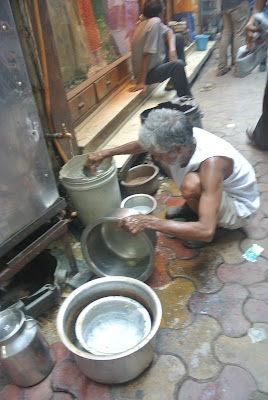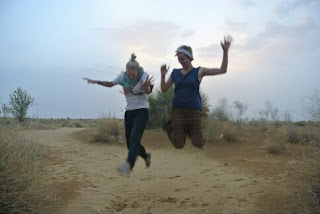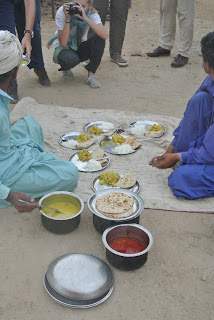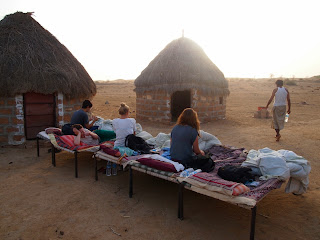The advanced open water course takes two days and consists of five dives. Two are compulsory - the deep dive and the navigation dive - and three are chosen as a way of bulking out our log books. We do a wreck, perfect bouyancy and night dive. Nick also manage to sneak in an extra fun dive, which he gives the title 'naturalist dive' or 'looking at fishes'. After just two days and 10 dives altogether I am an 'advanced' open water diver. I again don't find this very safe - I can dive to 30 meters, and at night, as long as I have a qualified buddy. There is no theory, and no test, its really just a matter of clocking up dives, which is pretty much what we do -just dive - particuarly on the bouyancy and navigaion dives. The deep, wreck and night dives are by far the most exciting and are the ones I am going to tell you about.
Deep Dive:
The deep dive takes us to thirty meters, where the water starts to get murky and cold. We descend slowly, circling the Chumphon pinnacle until we hit a thermodine, a cold patch of water at the very bottom. I hover slightly above 30 meters, at 28m, where the water is instantly warm again. At this depth we have to do a 'narc test', checking whether we have been affected by the concentration of nirogen we are now breathing due to the increased preassure. Nick holds up, for example, seven fingers, and in response we have to hold up however many equals eleven. In my case, I know that the answer is four, but I can't work out how many fingures makes four, holding up six and counting them off until I get the answer correct. Alex has to count Nick's fingers, then her own, and then starts giggling before eventually getting the answer correct.
There are fewer colourful fish at this depth, the most exciting thing we see is a huge school of barracuda swimming past, hardly visible in the murk. But it is exciting simply being so deep - turning over and looking up at the distant surface and the tonnes of water above. The preassure means the oxygen in our tanks does not last as long as it would at 18 meters, as we are breathing it in a more compressed form. Including descent and ascent time, we only stay down for about 25 minutes (with 15 minutes at the bottom), as opposed to our usual 45 minutes.
Wreck Dive:
The wreck is the HTMS Sattakut, a WWII American ship, sold to the Thai Navy who then gave it to BigBlue and sunk it for them, right next to another dive site, so that the near by marine life would spill over and inhabit it. We are dropped off by the boat on its way to the adjacent site, so we have to be ready to jump off quickly as it barely pauses. (We will then swim to where the boat and other divers are to be picked up). As we descend the wreck literally looms out of the darkness - Titanic style. It is not as big as I had thought, and we are not allowed to swim inside it (doing so is pretty much the only way we can fail the course) but it still fairly impressive. It sureal swimming around a completley submerged ship crawling with sea life. There is a huge gun mounted on the bow and I poke my head into the bridge to see an angry looking trigger fish. Unfortunately we don't see any giant squid or krakens - they're probably inside.
It tempts me to do the full wreck diving course, but then again I'm not a fan of confined, underwater spaces. At least in open water, even at 30 meters I can see and could swim to the surface if needed. Apparently the inside of the wreck is covered in silt which, if unsettled, creates a thick cloud making it impossible to even see one's own hand, let alone the exit. Maybe not.
Night Dive:
Having done three dives on the first day of our advanced course, we decide to do the night dive the next evening. The boat leaves at 18:30 and it is very stormy, not helping my pre-existing nerves regarding bobbing around on the surface (already my least favourite bit) before descending into darkness. We also have to learn new rules regarding hand signals, as one hand is now holding a torch, and correct usage of the torch - hold it down when descending, up when ascending, don't shine it in people's eyes, or directly at the fish. Although simple, I have only just learnt the previous set of hand signals, and its a lot to take in with waves constantly slapping me around the face, whilst trying to put my kit together in semi darkness on a boat which refuses to remain at one angle.
Eventually we're ready - we jump in, quicky descend and suddenly its calm. I can't even tell that there is a storm on the surface and the only sound is of my own breathing and a fizzing and crackling from the water around me. Below I can see columns of illuminated bubbles and just make out the divers making them. My torch casts a thin beam which highlights the grime in the water around me - which I assume is bits of plant life, fish, little sea bugs and general ocean-ness not visible in the day light. We are circling another pinnacle, this one called red rock. There is a strong current pulling us around, and sometimes into, the rock. There are lots of fish sleeping in crevices, and a lot of awake fish, who look startled when they move into my torch light (yes a fish can look startled). We see crabs, a baby moray, huge cowrie shells, shrimp and a sleeping trigger fish. It is not much different from the day time, just darker and quieter.
Although previously adamant I would not do a night dive I loved it. Nick had told us about glowing octopus and hunting barracuda, who make use of the torch light, and I can't wait to go again! In a few days time a friend from university (and a dive master!) is coming to Koh Tao and I am hoping to do lots of diving with her, at a hugely reduced price now that I am 'qualified' (I will still be very glad to have a dive master with me).
Deep Dive:
The deep dive takes us to thirty meters, where the water starts to get murky and cold. We descend slowly, circling the Chumphon pinnacle until we hit a thermodine, a cold patch of water at the very bottom. I hover slightly above 30 meters, at 28m, where the water is instantly warm again. At this depth we have to do a 'narc test', checking whether we have been affected by the concentration of nirogen we are now breathing due to the increased preassure. Nick holds up, for example, seven fingers, and in response we have to hold up however many equals eleven. In my case, I know that the answer is four, but I can't work out how many fingures makes four, holding up six and counting them off until I get the answer correct. Alex has to count Nick's fingers, then her own, and then starts giggling before eventually getting the answer correct.
There are fewer colourful fish at this depth, the most exciting thing we see is a huge school of barracuda swimming past, hardly visible in the murk. But it is exciting simply being so deep - turning over and looking up at the distant surface and the tonnes of water above. The preassure means the oxygen in our tanks does not last as long as it would at 18 meters, as we are breathing it in a more compressed form. Including descent and ascent time, we only stay down for about 25 minutes (with 15 minutes at the bottom), as opposed to our usual 45 minutes.
Wreck Dive:
The wreck is the HTMS Sattakut, a WWII American ship, sold to the Thai Navy who then gave it to BigBlue and sunk it for them, right next to another dive site, so that the near by marine life would spill over and inhabit it. We are dropped off by the boat on its way to the adjacent site, so we have to be ready to jump off quickly as it barely pauses. (We will then swim to where the boat and other divers are to be picked up). As we descend the wreck literally looms out of the darkness - Titanic style. It is not as big as I had thought, and we are not allowed to swim inside it (doing so is pretty much the only way we can fail the course) but it still fairly impressive. It sureal swimming around a completley submerged ship crawling with sea life. There is a huge gun mounted on the bow and I poke my head into the bridge to see an angry looking trigger fish. Unfortunately we don't see any giant squid or krakens - they're probably inside.
It tempts me to do the full wreck diving course, but then again I'm not a fan of confined, underwater spaces. At least in open water, even at 30 meters I can see and could swim to the surface if needed. Apparently the inside of the wreck is covered in silt which, if unsettled, creates a thick cloud making it impossible to even see one's own hand, let alone the exit. Maybe not.
Above: HTMS Sattakut (internet)
Night Dive:
Having done three dives on the first day of our advanced course, we decide to do the night dive the next evening. The boat leaves at 18:30 and it is very stormy, not helping my pre-existing nerves regarding bobbing around on the surface (already my least favourite bit) before descending into darkness. We also have to learn new rules regarding hand signals, as one hand is now holding a torch, and correct usage of the torch - hold it down when descending, up when ascending, don't shine it in people's eyes, or directly at the fish. Although simple, I have only just learnt the previous set of hand signals, and its a lot to take in with waves constantly slapping me around the face, whilst trying to put my kit together in semi darkness on a boat which refuses to remain at one angle.
Above: Heading out for the night dive
Eventually we're ready - we jump in, quicky descend and suddenly its calm. I can't even tell that there is a storm on the surface and the only sound is of my own breathing and a fizzing and crackling from the water around me. Below I can see columns of illuminated bubbles and just make out the divers making them. My torch casts a thin beam which highlights the grime in the water around me - which I assume is bits of plant life, fish, little sea bugs and general ocean-ness not visible in the day light. We are circling another pinnacle, this one called red rock. There is a strong current pulling us around, and sometimes into, the rock. There are lots of fish sleeping in crevices, and a lot of awake fish, who look startled when they move into my torch light (yes a fish can look startled). We see crabs, a baby moray, huge cowrie shells, shrimp and a sleeping trigger fish. It is not much different from the day time, just darker and quieter.
Although previously adamant I would not do a night dive I loved it. Nick had told us about glowing octopus and hunting barracuda, who make use of the torch light, and I can't wait to go again! In a few days time a friend from university (and a dive master!) is coming to Koh Tao and I am hoping to do lots of diving with her, at a hugely reduced price now that I am 'qualified' (I will still be very glad to have a dive master with me).









































